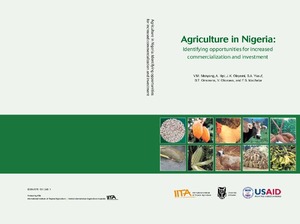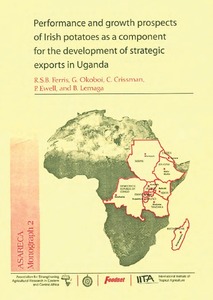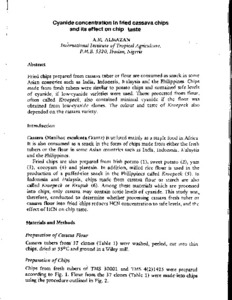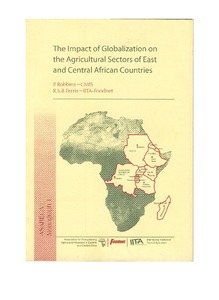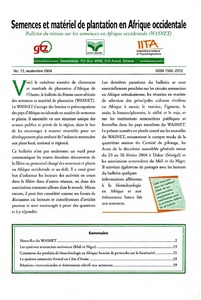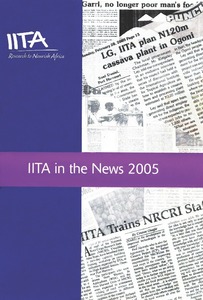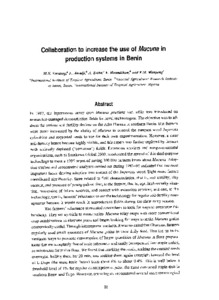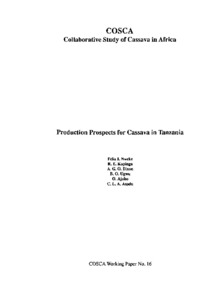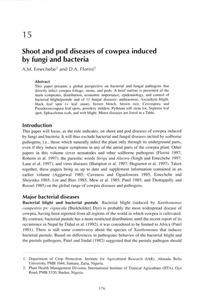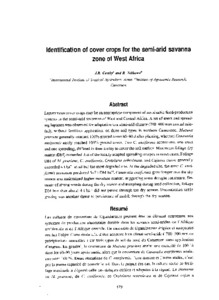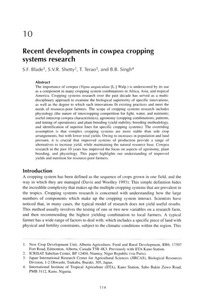Welcome to the International Institute of Tropical Agriculture Research Repository
Books and Book Chapters: Recent submissions
Now showing items 681-700 of 977
-
IITA Annual Report 2002
(2003) -
New food products from cassava
(2003) -
Impact of IITA germplasm improvement on maize production in West and Central Africa
(2003)The International Institute of Agriculture (IITA) is among the major suppliers of genetic materials to national agricultural research and extension systems in West and Central Africa for the development of improved maize varieties. This paper presents the results of a survey of the impact of germplasm from IITA on maize production and food security in 11 countries, which together contain over 90% of the area cultivated to maize in West and Central Africa. Between 1965 and 1998, the public sectors ... -
Mucuna fallow diffusion in southern Benin
(1999)Population pressure in the southern provinces of Benin has forced farmers to shorten or abandon the traditional bush fallow system. As a consequence, severe soil degradation and weed infestation constitute the most serious constraints to agricultural productivity. Mucuna fallow is one of the most promising technologies for natural resource management to restore soil fertility in intensified crop-ping systems. It was introduced in 1987 to some 15 farmers through farmers' participatory research in ... -
Collaboration to increase the use of Mucuna in production systems in Benin
In 1987, the leguminous cover crop Mucuna pruriens var. utilis was introduced on researcher-managed demonstration fields for novel technologies. The objective was to ad-dress the serious soil-fertility decline on the Adja Plateau in southern Bénin. But farmers were more impressed by the ability of Mucuna to control the rampant weed Imperata cylindrica and requested seeds to use for their own experimentation. However, a clear soil-fertility bonus became highly visible, and this aspect was further ... -
Production prospects for cassava in Tanzania: COSCA working paper, No. 16
Several cassava genotypes were observed although there were few bred varieties. The wide diversity in the cassava landraces was a consequence of the action of the farmers in continuously abandoning and introducing cultivars into their system as they tried to select those cultivars that met their needs. These included extended in ground storability in remote areas, high lOOt yield, and earliness in high demographic pressure areas, low cyanogen level in specific areas where the sweet cassava type ... -
Shoot and pod diseases of cowpea induced by fungi and bacteria
(1997)This paper presents a global perspective on bacterial and fungal pathogens that directly infect cowpea foliage, stems, and pods. A brief outline is presented of the main symptoms, distribution, economic importance, epidemiology, and control of bacterial blight/pustule and of 11 fungal diseases: anthracnose, Ascochyta blight, black leaf spot (= leaf smut), brown blotch, brown rust. Cercospora and Pseudocercospora leaf spols. powdery mildew. Pythium soft stem rot. Septoria leaf spot. Sphaceloma scab, ... -
Identification of cover crops for the semi-arid savanna zone of West Africa
Leguminous cover crops may be an appropriate component of sustainable food-production systems in the semi-arid savannas of West and Central Africa- A set of erect and spreading legumes was observed for adaptation D to a semi-arid climate (700-900 mm annual rain-fall), without fertilizer application, on three soil types in northern Cameroon. Mucuna pruriens generally reached l00% ground cover 60-90 d after planting, whereas Canavalia ensiformis rarely reached 100% ground cover, Two C. ensiformis ... -
Recent developments in cowpea cropping systems research
(1997)The imponance of cowpea (Vigna unguiculata [L.] Walp.) is underscored by its use as a component in many cropping system combinations in Africa, Asia, and tropical America. Cropping systems research over the past decade has served as a multidisciplinary approach to examine the biological superiority of specific innovations, as well as the degree to which such innovations fit existing practices and meet the needs of resource-poor farmers. The scope of cropping systems research includes physiology ... -
The feasibility of classical biological control of two major cowpea insect pests
(1997)Biological control, as a key component of biointensive IPM in cowpea, is evaluated for its practical feasibility. The case study of one of the major insect pests, the bean flower thrips Megalumthrips sjosredti (Trybom) (Thysanoptera, Thripidae), is used to indicate the most important criteria for this evaluation: the nature of the pest and the release habitat, the availability and effectiveness of biological control agents, and the current status of biocontrol against the target pest. Although ... -
Origin, taxonomy and morphology of Vigna unguiculata (L.) Walp
(1997)Cowpea (V. unguiculata) represents the main food legume in tropical Africa. Germplasm collecting missions launched over the past 10 years have provided genebanks with a wide array of variability within the cultivated and wild taxa of the species. Based on detailed studies on morphological diversity of live materials along with extensive survey of materials in major Vigna herbaria and ecogeographical information, a new intra specific classification recognizing 13 varieties of wild cowpea has been ... -
Oppotunities for biotechnology in cowpea
(1997)Several applications of biotechnology have been successfully used recently in cowpea. A molecular map of cowpea has been constructed using RFLP markers, and this has already facilitated the localization of certain quantitative trait loci; gene chromosome localization using in situ hybridization is in progress. Appropriate bioassays have been developed that have facilitated the identification of candidate genes for insect pest resistance in cowpea, including Bacillus rhttrins>ensis protoxin genes, ...


